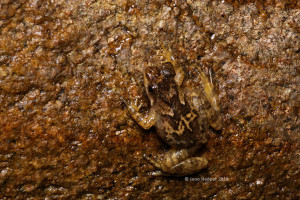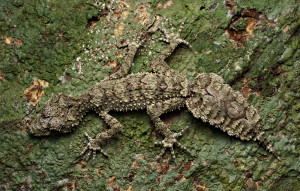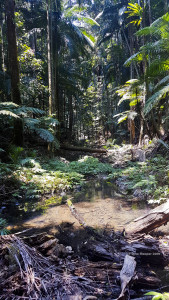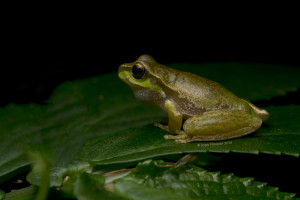For many years now I have been unsatisfied in assuming Conondale’s ‘lost’ frogs are indeed lost (i.e. extinct). I am, of course, referring to the Southern Gastric Brooding Frog (Rheobatrachus silus) and the Southern Day Frog (Taudactylus diurnus), last seen in the wild in 1981 and 1979, respectively, and now both presumed extinct. My dissatisfaction in assuming both species are extinct arises from two points; one, that thorough searches for both species have not been undertaken in almost 20 years – perhaps some populations not entirely wiped out by Chytridiomycosis (referred to herein as Chytrid fungus*) have since recovered to the point they are now detectable, and two, other species which have been ‘missing’ or presumed extinct, have be rediscovered.

On the second point; two species instantly come to mind; the critically endangered Armoured Mistfrog (Litoria lorica) and endangered Eungella Dayfrog (Taudactylus eungellensis), rediscovered in 2008 and 1992, respectively. The Armoured Mistfrog had not been seen since 1994 and was rediscovered in 2008. The Eungella Dayfrog disappeared in 1985 and was rediscovered in 1992. Interestingly, the single Armoured Mistfrog population was discovered in very different habitat from where the original populations were known – but more on this later.

A third example, though unique to the other two examples, is the discovery of the Border Ranges Leaf-tail Gecko (Saltuarius swaini) on Mt Glorious, just west of Brisbane. The discovery (made by my good mate Ben Revell), places this population 80kms north of existing records. But most surprising is the realisation that this species had not been discovered many years earlier, considering how frequented the area is by herpetologists young and old, past and present. Need I go on with further examples of species rediscovered in Australia and oversees?
Site Selection

The next step in my search for Conondale’s lost frogs would involve thorough desktop review of literature and satellite imagery with associated relevant mapping/GIS layers. But where would I begin my search? After all, there are so many tributaries within the national park; some surveyed historically whilst others barely surveyed at all, if at all. Rather than commence surveys blind, it made sense to try select sites where Chytrid fungus may not survive as well throughout the year. I discussed site selection with friends and experienced ecologists Dr Ed Meyer and Harry Hines and our consensus for the following criteria were:
- Selecting sites which have little canopy cover, allowing the sun to penetrate through to the creek below, warming the water and rocks to temperatures less conducive to Chytrid survival. This theory was put forward to explain why the Armoured Mistfrog, mentioned above, have survived at an exposed site quite different to historical core habitat sites;
- Sites at lower altitude; lower altitude sites are thought to be less conducive to Chytrid survival, as they are generally warmer than higher altitude sites. Another rediscovered species, the aforementioned Eungella Dayfrog populations, also occur at lower altitude sites; and
- The third criteria is water permanency. Given the almost entirely aquatic lifecycle of the Southern Gastric Brooding Frog, sites which may support this frog since 1981 would need water to remain through dry periods.
In addition to the above criteria, my preference was to select sites where the two Conondale species were not historically known from; given the almost guaranteed chance of historical sites still containing Chytrid fungus today. A moderated spreadsheet of historical frog locations and survey sites provided to me helped in determining new or poorly surveyed sites to try. And so with about half a dozen survey sites chosen, I planned a week in November 2019 dedicated to survey site reconnaissance and surveys for Conondale’s lost frogs. In total, four sites were surveyed diurnally, and three of these surveyed nocturnally (explanation below).
Survey Conditions

Conditions leading up to and during the week of the Conondale frog search would generally be considered as average. In fact, they were below average. Substantial rainfall had not fallen across the Sunshine Coast hinterland since March-April 2019; consequently the region, as are many others in SEQ was drought-declared. Another consequence was that two of the four creek systems we planned to survey had dried up, in that there was no surface flow and only isolated pools of water remained. The other two creeks had very low basal flow. Daytime temperatures had been warm too, and the vegetation and groundcover was dry. Only a week before had bushfires torn through pine plantations around Jimna. Despite these conditions, they were not considered too detrimental to the frog surveys, for these reasons:
- The Gastric-brooding Frog and Southern Day Frog were almost entirely aquatic species, particularly the aforementioned frog, and so providing water still remained along creeks, it was still worthwhile to survey these sites. Only one creek was completely dry and had been for some time, and so a nocturnal survey was deemed irrelevant;
- The very dry conditions allowed me to determine which creek systems these frogs (if still present) were likely to have persisted through drought conditions since their last sighting in the wild. In other words, those creeks which dried up were considered unlikely to have provided habitat for an aquatic frog during drought conditions over the last ~40 years; and
- The dry and low basal flow creeks made for easier traversing and searching, given the low or absent water level. Our focus could therefore also be given to individual pools rather than large stretches of flowing creek.
Survey Methodology

Our survey methodology consisted of the following:
- Each stretch of creek (transect) would be surveyed diurnally and nocturnally. Having read up on the known ecology of the frogs, and spoken to several ecologists who worked on the species in the 70s and 80s, I learnt the frogs were often known to ‘sunbask’ during the day. Surveying only at night, as is typically done for frogs, would risk not detecting these two species when active during the day.
- Transects were often ~>1.3km long as this ensured the entire 300-450m elevation was surveyed, since this is considered the elevation most suited for lingering lost frog populations.
- During a conversation with Dr Glen Ingram, he recalled they would often find Southern Gastric-brooding Frogs by the ripples the frogs would make as they dived under the water’s surface. Prior to the frog being disturbed, it would rest on a rock or more often sit in the shallows with its head above water. When disturbed, the frog would dive under a rock/boulder in the creek. Therefore, during our current surveys we would scan the water’s surface before us looking for such ripples of a diving frog.
- Whilst not a favoured survey method of mine, searching under rocks was another method we used during our search. Dr Ed Meyer recalled this method was not incorporated during the FrogSearch surveys of the 90s, and recommended I include this method during my current surveys (as we know the Gastric Brooding Frog would shelter under rocks if disturbed). Rocks and small boulders were therefore lifted and searched under before placing back into position. The low water levels aided in this task, however the accumulation of detritus in some pools reduced visibility in the water as we’d lift up some rocks. On these occasions we used our hand to feel around beneath the rock.
- Call playback was utilised for several key species including the Southern Gastric-brooding Frog and both endangered barred frog species;
- Weather conditions and other ambient conditions were noted for each survey, as was survey start and finish time. An incidental list of all other fauna encountered during each surveys was also recorded.
- Two observers walked each transect to account for surveyor search bias and increase the detection of frogs and other fauna present.
Survey Outcomes

Over 4km of potential habitat was surveyed (~7km surveyed in total), resulting in eight species of frog (plus the Cane Toad) encountered during the five night search:
- Stony-Creek Frog (Litoria wilcoxii);
- Southern Orange-eyed Treefrog (Litoria chloris);
- Cascade Treefrog (Litoria pearsoniana);
- Emerald-spotted Treefrog (Litoria peronii);
- Eastern Sedgefrog (Litoria fallax);
- Tusked Frog (Adelotus brevis);
- Great Barred Frog (Mixophyes fasciolatus);
- Australian Marsupial Frog (Assa darlingtoni); and
- Cane Toad (Rhinella marina)

Encouragingly, many dozen Stony-Creek Frogs, Cascade Treefrogs and Tusked Frogs were recorded across all three creek transects surveyed. Two species notably absent were the endangered Giant Barred Frog (Mixophyes iteratus) and the endangered Fleay’s Barred Frog (Mixophyes fleayi), but total absence of a species from a site cannot be inferred from a single survey. Suitable habitat for both species occurs at two of the three sites surveyed, and surveying under more suitable conditions (ideally following decent rainfall and increased stream hight) on several occasions is required before such conclusion could be made.

As for Conondale’s two lost frogs? Neither were detected. However, seemingly suitable habitat was detected at all three survey sites, where both species in theory could take refuge and persist during the heights of Chytrid fungus prevalence. Unfortunately, Stony-creek Frogs are known to harbour the disease and act as vectors, potentially introducing and sustaining the disease at sites not previously impacted. Indeed, large numbers of Stony-creek Frogs were detected at two of the three transects and may have crippled any chances of the lost frogs surviving at these particular survey sites.
Next Step
Future surveys are intended along these three transects under more ‘normal’ (i.e. wetter) conditions. Other survey sites have also been chosen for future surveys, in the quest to provide current, objective survey data and bring closure to the lingering question, “Could Conondale’s lost frogs still exist?”.
Acknowledgements
I’m very grateful to Ollie Scully and Daniel McCawley for their selfless time and company during the week of ‘lost frog’ surveys, and to Harry Hines of QPWS and Dr Ed Meyer for guiding aspects of the targeted survey and data provision.


Very good read! I along with you still have alot of hope that the Rheobatrachus silus is still out there somewhere. Thankyou, good luck and i hope your efforts prevail!
Thanks Jono, Your blog gives inspiration to still go and have a look out there, every now and then. You never know, if you never go.